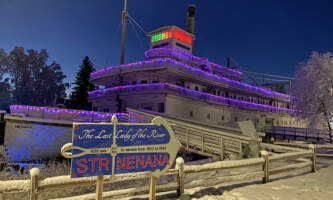The Riverboat SS Nenana is a sternwheeler nicknamed the “The Last Lady of the River.” She was commissioned by the Alaska Railroad and built-in 1932. She was prefabricated in Seattle and then shipped to Seward by regular steamship lines. Then, she was transported 450 miles on the Alaska Railroad to Nenana, Alaska, where she was constructed. She plied the Tanana and Yukon Rivers from 1933 to 1954, and her primary run was between Nenana and Marshall—a distance of about 858 miles.
The Riverboat SS Nenana was a packet ship that carried cargo and passengers;she had sleeping accommodations for up to 50 passengers but was only licensed to carry 16 passengers because of only having two lifeboats, except during World War II when she carried up to 50 military personal because she was Federally owned. She could hold up to 300 tons of cargo and push up to six barges on the Yukon. However, on the Tanana, she only pushed one barge at a time because the river was narrower and had more winding twists and treacherous conditions.
The Riverboat SS Nenana originally burned wood—roughly a cord of wood an hour—and there was storage for 230 cords of wood. In 1948, she switched to burning oil. The boat’s engines had the most advanced design of the time: twin, tandem 330-horsepower horizontal condensing engines. The engine could recycle approximately 85% of its steam into water, and the design allowed the boat to operate quietly. The sternwheeler traveled approximately 17 mph downriver and 7 mph upriver. Her draft was 36” when empty, 44” when fully loaded. She is 237 feet long, has a width of 42 feet, and is 5 decks high, complete with flushing toilets and showers.
The boat is currently undergoing restoration. The sternwheeler is the second largest wooden hull vessel in the world and the last wooden hulled sternwheeler in the nation. It was listed on the National Register of Historic Places in 1972 and named a National Historical Landmark in 1989.


